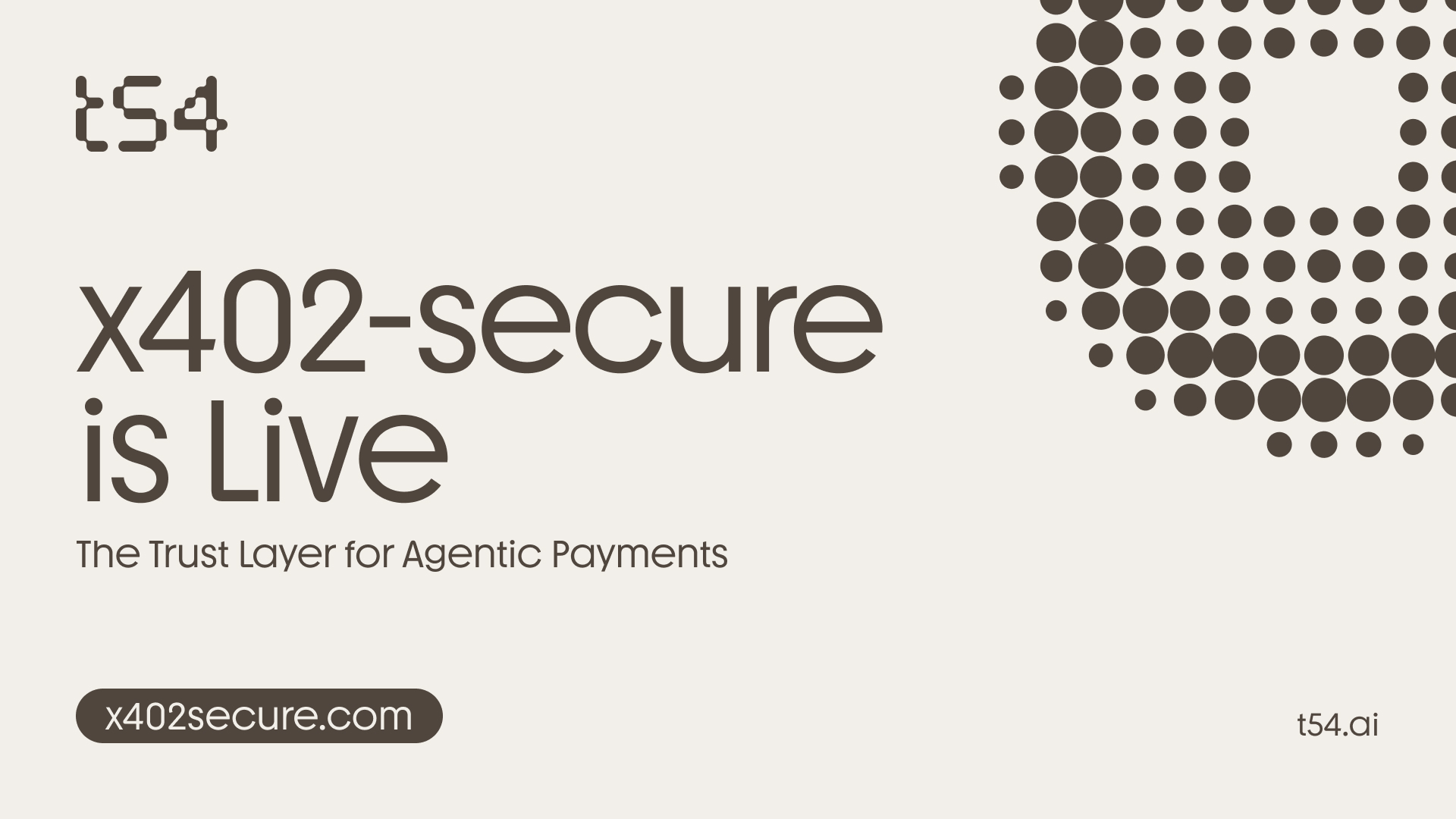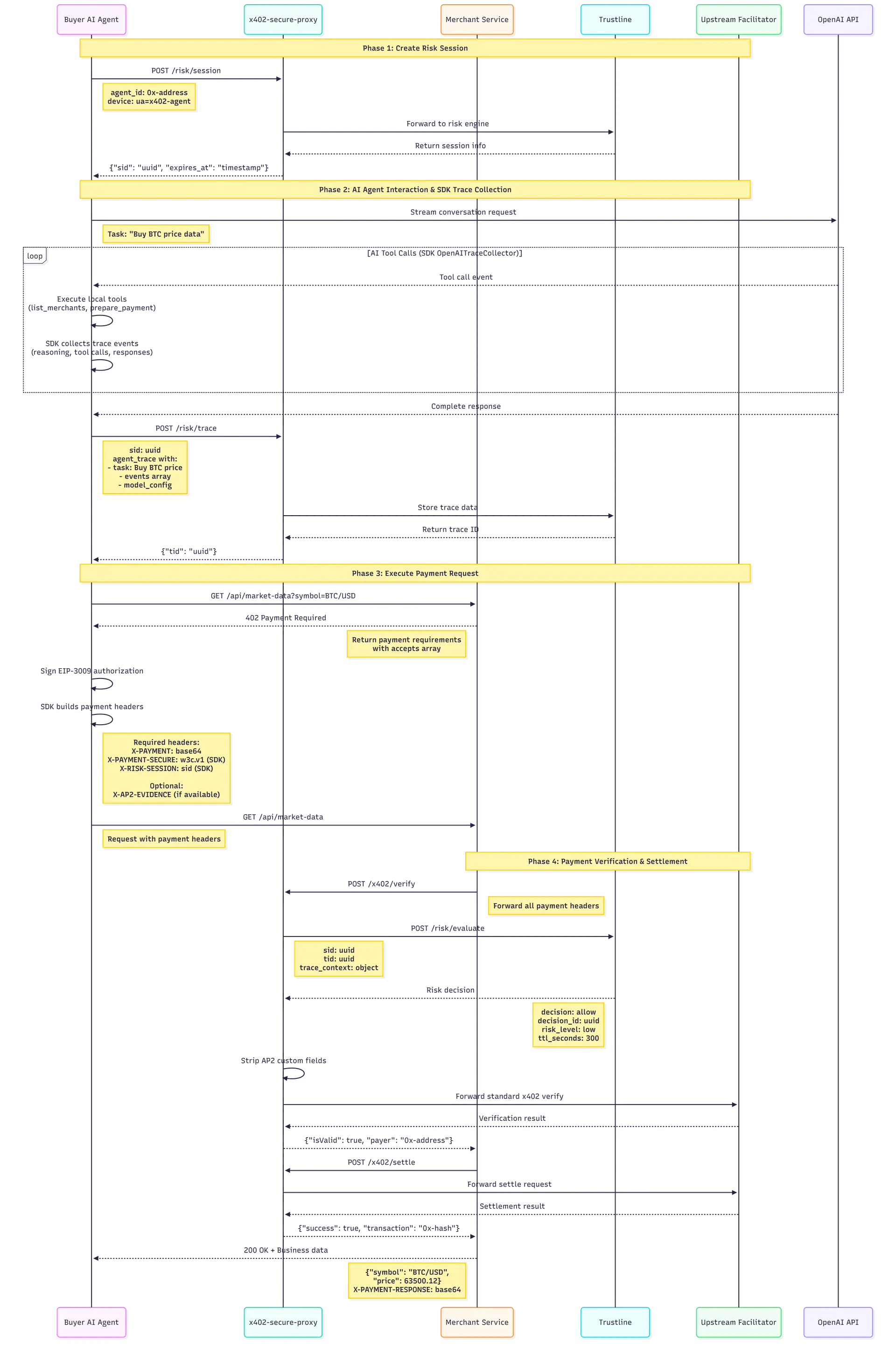x402-Secure
Secure every agent payment on x402
Open-Source SDK & Proxy for Secure Agent Payments on x402 — powered by Trustline from t54





Overview
x402-secure is the open-source gateway that connects AI agents to Trustline, t54’s agent-native risk engine. Together, they enable safe, accountable, and compliant agent-to-agent or agent-to-service payments.
What Trustline Provides
- Logic-level risk assessment on the agent’s reasoning chain
- Real-time fraud and anomaly detection
- Cryptographic evidence for dispute resolution
- Agent-native compliance and audit trails
What x402-secure Adds
- Agent SDK for trace collection
- Facilitator proxy aligned with the x402 payment protocol
- Liability protection for both agent developers and service providers
- Production-grade proxy integrated with Trustline’s real-time risk layer
x402-secure now supports Base and Solana
x402-secure is fully compatible with both chains through the x402 protocol. Agents settling payments on Base or Solana receive the same pre-transaction risk assessment, behavioral verification, and liability attribution offered by Trustline.
Quick Start
This section helps you spin up the proxy locally for testing.
Prerequisites
- Python 3.11 or 3.12
- uv package manager
Setup
# 1. Clone repository
git clone https://github.com/t54-labs/x402-secure
cd x402-secure
# 2. Create virtual environment & install dependencies
uv venv
uv sync
# 3. Copy and configure environment
cp env.example .envEdit .env and update:
PROXY_LOCAL_RISK=1
PROXY_UPSTREAM_VERIFY_URL=https://x402.org/facilitator/verify
PROXY_UPSTREAM_SETTLE_URL=https://x402.org/facilitator/settleRun the Proxy
uv run python run_facilitator_proxy.pyVerify with:
curl http://localhost:8000/healthCommon issues
500 risk endpoints: ensurePROXY_LOCAL_RISK=1for local testing.- Port conflict: adjust
PROXY_PORTin.envor free port 8000.
Next steps
- See full developer guide at docs/DEVELOPMENT.md
- Browse sample integrations under examples/
Why x402-secure
The Challenge
If you build AI agents that transact:
- How do you prevent unauthorized purchases?
- Who bears liability when an agent errs?
- How do you prove the agent’s reasoning was sound?
If you run APIs or services accepting agent payments:
- How do you verify agent-initiated transactions?
- How do you resolve disputes automatically?
The Solution
x402-secure enforces clear, verifiable responsibility boundaries through:
- Reasoning trace capture
- Real-time risk evaluation via Trustline
- Immutable evidence storage
- Programmatic dispute protection
For AI Agent Developers
Use Case: you’re building an agent that spends on behalf of users.
What You Get
- Automatic liability coverage for approved transactions
- Evidence of reasoning for every payment
- Risk checks before settlement
- SDK with simple integration
Integration (Python Example)
pip install x402-secure
from x402_secure_client import BuyerClient, BuyerConfig, RiskClient, OpenAITraceCollector
from x402_secure_client import store_agent_trace, execute_payment_with_tid
buyer = BuyerClient(BuyerConfig(
seller_base_url="https://api.example.com",
agent_gateway_url="https://x402-proxy.t54.ai",
buyer_private_key=YOUR_PRIVATE_KEY
))
risk = RiskClient("https://x402-proxy.t54.ai")
session = await risk.create_session(agent_did=buyer.address, app_id="my-agent-v1")
sid = session["sid"]
tracer = OpenAITraceCollector()
# ...collect reasoning stream...
tid = await store_agent_trace(risk, sid, "purchase_item", {"item": "coffee maker"}, tracer.events)
payment = await execute_payment_with_tid(
buyer, "/api/purchase", "purchase_item",
{"item": "coffee maker"}, sid, tid
)For full SDK reference, see Buyer Integration Guide.
For API / Service Providers
Use Case: your API accepts agent payments.
What You Get
- Risk score attached to each transaction
- Proof-of-intent for disputes
- Seamless integration via standard x402 headers
Example Integration (FastAPI)
from fastapi import FastAPI, Request
from fastapi.responses import JSONResponse
from x402_secure_client import SellerClient
app = FastAPI()
seller = SellerClient("https://x402-proxy.t54.ai/x402")
@app.get("/api/service")
async def service(request: Request, param: str):
# define payment requirements
reqs = {"network": "base-sepolia", "maxAmountRequired": "100000", "asset": "0x...USDC"}
xpay = request.headers.get("X-PAYMENT")
secure = request.headers.get("X-PAYMENT-SECURE")
sid = request.headers.get("X-RISK-SESSION")
if not all([xpay, secure, sid]):
return JSONResponse({"accepts": [reqs]}, status_code=402)
result = await seller.verify_then_settle(json.loads(base64.b64decode(xpay)), reqs,
x_payment_b64=xpay, x_payment_secure=secure,
risk_sid=sid)
return JSONResponse({"status": "ok", "result": result})Detailed server integration guide: Seller Integration Guide
How It Works
Flow summary
- Agent creates a risk session via the proxy.
- Reasoning trace collected and stored by Trustline.
- Agent sends payment with risk headers through x402.
- Proxy validates payment, consults Trustline, and settles upstream.
- Result returned with signed evidence.

Resources
- Developer Documentation
- tLedger Quick Start
- Trustline Risk Engine
- Agentic Finance Overview
- Play x402 Monopoly
For questions or support: [email protected] Community: discord.gg/t54labs
Updated 9 days ago